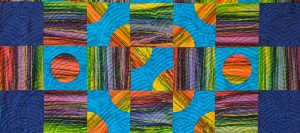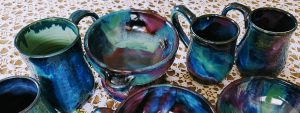*Raku cat by Peter Alsen, Fabric Art by Judy Harper
When you visit Valley Art you can find the delightful, colorful and whimsical work of Peter Alsen. But that playfulness shouldn’t distract you from the skill and time needed to create the accomplished work. Peter took the time to go over his process with us.
Can you tell us a bit about yourself, please?
I grew up in Roseburg where I was introduced to pottery in high school. I continued to pursue ceramics at the U of O but eventually ended up working as an industrial designer for a large engineering company. In the early 90’s I joined a studio in Georgia and began producing pots at night and on weekends and selling regionally through galleries. In 2008, I retired and returned to Oregon where I continue to sell in galleries and a limited number of shows.
When and how did you start working in clay?
My high school instructor was very accomplished and added lots of sculptural elements to his thrown pots. This has found its way into my work. I also learned early that I could combine thrown forms and create a piece that that was more complex than my limited ability at the time would normally be able to produce.
Your work is very sculptural and delightfully figurative. Did you do a great deal of wheel-throwing early on, or did spontaneously gravitate toward sculpting?
My early influences led my to add sculptural handles and attachments to my pots. Over time, I started combining throw forms to create animal forms. As my gallery sales increased a larger percentage of my sales became thrown and sculpted animals. Since retiring I have had more time to play, and the variety of sculpted critters has increased.
Your work seems to be primarily in Raku, how did Raku become your main or preferred method of expression?
The studio in Georgia was limited to electric fire and Raku. The options for electric fire did not seem as interesting as the Raku. I took over the Raku kiln. The studio was shared with a clay supplier who gave me access to lots of glaze material and this allowed for developing a palette of different colors.
What is your normal workday like?
I produce in cycles based on the size of my bisque kiln. It typically holds about 35 pieces which is about a month’s production. So I work in groups of 12. I throw the parts for about 12 animals one day and spend the next day or two assembling them, then I begin the process all over again until I have a kiln load. After bisque, I begin the glazing cycle. I get about 5 pieces in a load in the Raku kiln, so I glaze up 15 to 20 things, fire them and do it again until glazed out.
The gallery was not found!What do you find most challenging about working with clay?
I like to come up with several new things each year and this keeps me constantly searching for inspiration.
What is most challenging, and most rewarding about Raku in particular?
Working in the extreme heat of the Raku kiln gets tougher as I get older, although firing in Oregon is much easier than trying to get out 6 loads in the Georgia heat and humidity. I‘ve always said Raku makes everything look good, so it is very gratifying to see the finished work when the clay has blacked and the crackle pops.
Do you do drawings or illustrations of your subjects before committing your ideas to clay?
I always draw out something new before I make it. This allows me to figure out the shapes I need to throw. I also find it saves time to experiment on paper than on the wheel. **Answer here
What is your Raku process?
It is pretty much the same as everyone else except I put my pieces into sawdust and then cover them with a can. This allows me to lift the can and add more sawdust. I feel this facilitates me achieving dark crackle all over the pot.
What advice would you give to budding clay artist?
Develop a line of work. Make what you enjoy. Be different.
Contact Peter on social media for commissions or more information about his work at Alsen Pottery




